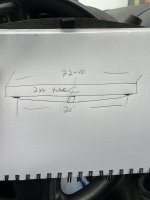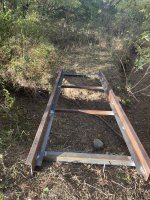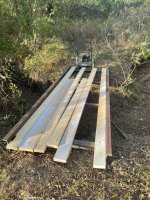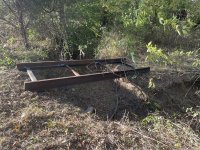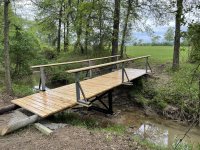kenmbz
Super Star Member
- Joined
- May 8, 2019
- Messages
- 10,901
- Location
- S.E. PA
- Tractor
- Massey Ferguson GC1720/JD x360/Echo CS-490/CS-620
Brings me back to my college days, statics and dynamics class.Just google steel beam deflections and steel beam stress.
You will get all kinds of formulas......distributed loads, point loads, etc.
But all common steel has given properties. All common I-beam shapes, Channel, tube, etc.
Its simply math from that point. The key spec you are looking for to calculate deflection is called moment of inertia (i⁴) You can get some I-beam specs here W-Beams - American Wide Flange Beams
The LIGHTEST 10" I-beam they list is a W10x12. Meaning 10" tall and 12lbs per foot. And has a moment of inertia of 53.8
For simple deflection with a load at mid span.....(WLᶟ)/(48Ei⁴)
In other words......weight times the length in inches cubed.....divided by 48 times modulus of elasticity times i⁴
Modulus of elasticity of steel is 30,000,000
So, with 3000 pounds at the middle of a 22' span:
(3000 x 264 x 264 x 264)/(48 x 30,000,000 x 53.8) = 0.712" of deflection.
You should try and keep deflection under L/360. So 264"/360 = 0.733 So a pair of those beams in theory is good to a little more than 6000# total at midspan with a point load.
But with steel members that arent common.......or listed anywhere.....for example if your trailers I-beams arent actually I-beams but rather plates of steel welded together.....or in the OP's case of maybe stiffening tubing with cable or strap or re-bar.....makes it VERY complicated to calculate the moment of inertia. And therefore very difficult to assign a proper load value. Because alot more things come into play other than just raw steel. For example.....quality of the welds, enough weld contact area, bracing, etc.
A fun little tool/calculator I downloaded years ago so I dont know if its still avalialbe is called BeamBoy. It calculates all the stress and deflection for a given shape. And they have alot of shapes already stored in the program with the relevant parameters.
So in the above example of the 22' span and W10x12 beam it looks like this:
View attachment 788655
View attachment 788656
So glad this is all in books/online for lookup now.
The formulas always gave me headaches deriving them.
